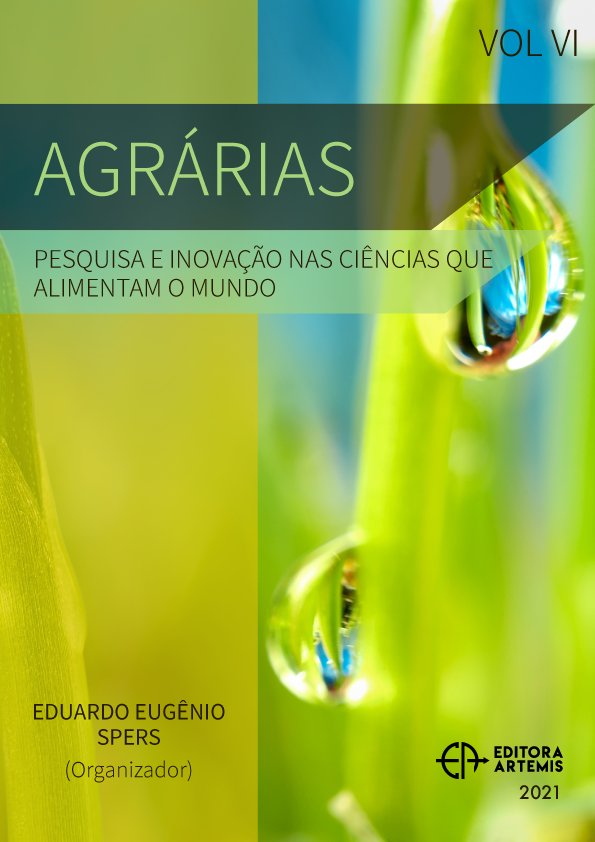
FUNCTIONALITY AND PHYSICOCHEMICAL PROPERTIES OF THE CHIRIMOYA FLOUR (ANNONA CHERIMOLA MILLER) CV. CUMBE
O objetivo do estudo foi aproveitar os frutos da cherimoya (Annona cherimola Miller), que apresentavam baixo calibre para comercialização in natura e que permitiriam obter uma farinha com propriedades físico-químicas e funcionais adequadas para a indústria alimentícia. Para isso, os frutos com até 3 dias de coleta foram condicionados manualmente para a obtenção de sua polpa, que foi laminada a 3 ± 1 mm de espessura e desidratada em secador convectivo a 50 ° C e velocidade do ar de ~ 3 m / s, até peso constante. Posteriormente, foi moído e peneirado em malha 80 para obtenção da farinha de cherimoya (HCh). Os resultados expressos como a média ± DP de pelo menos três experimentos independentes; onde foram obtidos valores de aw de 0,332 ± 0,025, umidade de 12,04 ± 1,23%, pH de 5,46 ± 0,05 e ° Brix de 20,00 ± 0,01. A análise das coordenadas de cores do CIELab para o HCh encontrou uma luminosidade (L *) de 87,9 ± 0,9, valor a * de 1,5 ± 0,3 e valor b * de 14,3 ± 2,0, definindo uma cor branco amarelada. Os testes de funcionalidade renderam valores de densidade aparente (ρa) de 0,4746 ± 0,019, densidade compactada (ρc) de 0,5514 ± 0,0123, coesividade pela Razão de Hausner (HR) de 1,1623 e fluidez pelo índice de Carr (CI) de 13,94%; valores que conferem "baixa coesão" e "fluidez muito boa" ao HCh. Da mesma forma, o índice de solubilidade (ISA), índice de absorção de água (IAA) e capacidade de retenção de óleo (CRA) determinados obtiveram valores de 27,10 ± 2,55%, 2,6036 ± 0,2466 g H2O / ge 1,0742 ± 0,0930 g óleo / g, respectivamente. Em conclusão, a Farinha de Cherimoya possui propriedades físico-químicas e funcionais que possibilitam sua utilização como substituto de outras farinhas comerciais utilizadas em diversas matrizes alimentares.
FUNCTIONALITY AND PHYSICOCHEMICAL PROPERTIES OF THE CHIRIMOYA FLOUR (ANNONA CHERIMOLA MILLER) CV. CUMBE
-
DOI: 10.37572/EdArt_3004213542
-
Palavras-chave: Annona cherimola Miller, farinha de Cherimoya, Propriedades funcionais.
-
Keywords: Annona cherimola Miller, Cherimoya flour, Functional properties.
-
Abstract:
The objective of the study was to take advantage of the fruits of cherimoya (Annona cherimola Miller), which presented low caliber for fresh marketing and that would allow obtaining a flour with adequate physicochemical and functional properties for the food industry. For this, the fruits of up to 3 days of collecting were manually conditioned to obtain their pulp, which was laminated to 3 ± 1 mm thick and dehydrated in a convective dryer at 50 ° C and an air velocity of ~ 3 m / s, until constant weight. Subsequently, it was ground and sieved using an 80 mesh to obtain cherimoya flour (HCh). The results expressed as the mean ± SD of at least three independent experiments; where aw values of 0.332 ± 0.025, the humidity of 12.04 ± 1.23%, pH of 5.46 ± 0.05 and ° Brix of 20.00 ± 0.01 were obtained. The analysis of the CIELab Color coordinates for the HCh found a luminosity (L *) of 87.9 ± 0.9, a * value of 1.5 ± 0.3 and a b * value of 14.3 ± 2.0, defining a yellowish-white color. The functionality tests yielded values of apparent density (ρa) of 0.4746 ± 0.019, compacted density (ρc) of 0.5514 ± 0.0123, cohesiveness by the Hausner Ratio (HR) of 1.1623 and fluidity by Carr index (CI) of 13.94%; values that give "low cohesiveness" and "very good fluidity" to HCh. Likewise, the solubility index (ISA), water absorption index (IAA) and the oil retention capacity (CRA) determined obtained valuables of 27.10 ± 2.55%, 2.6036 ± 0.2466 g H2O / g and 1.0742 ± 0.0930 g oil / g, respectively. In conclusion, cherimoya Flour has physicochemical and functional properties that make possible to use as a substitute input for other commercial flours used in various food matrices.
-
Número de páginas: 10
- Erick Alvarez Yanamango
- Roberto Chuquilín-Goicochea
- Fredy Huayta Socantaype
- Gladys Arias Arroyo

